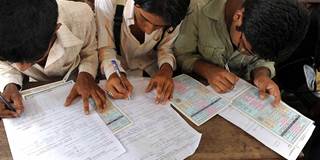Concerns about job creation and employment are heating up in India, fueled by data that seem to show the country is entering a period of jobless growth. But there are two reasons to be skeptical: bad data, and an increase in gainful employment.
MUMBAI – A debate about job creation and employment is heating up in India, fueled by data that seem to show the country is entering a period of jobless growth. Official statistics suggest that overall labor-force participation declined between 2011 and 2015, with fewer than two million new jobs created annually.
If those numbers were the whole story, then India, a country where 16 million people reach working age every year, would be heading for economic trouble. There are two reasons to doubt that it is. First, the Labor Bureau’s figures do not provide a full accounting of the country’s labor force; many of India’s 460 million workers, especially the self-employed, are simply uncounted in official surveys. Second, the data fail to account for the quality of new jobs being created. As India’s labor market evolves in line with the shift toward a non-agricultural economy, the creation of “gainful employment” – safer, higher-paid, and more productive jobs – will be the true measure of economic health.
The dearth of timely, reliable data has long been an impediment to the analysis of trends in India’s labor market. Current government statistics that rely on quarterly surveys do not provide a complete picture of what is happening nationwide. For example, they track only those enterprises with more than ten employees, which represent less than 2% of the national total – indicative of the low quality of work in which the vast majority of Indians are engaged.

MUMBAI – A debate about job creation and employment is heating up in India, fueled by data that seem to show the country is entering a period of jobless growth. Official statistics suggest that overall labor-force participation declined between 2011 and 2015, with fewer than two million new jobs created annually.
If those numbers were the whole story, then India, a country where 16 million people reach working age every year, would be heading for economic trouble. There are two reasons to doubt that it is. First, the Labor Bureau’s figures do not provide a full accounting of the country’s labor force; many of India’s 460 million workers, especially the self-employed, are simply uncounted in official surveys. Second, the data fail to account for the quality of new jobs being created. As India’s labor market evolves in line with the shift toward a non-agricultural economy, the creation of “gainful employment” – safer, higher-paid, and more productive jobs – will be the true measure of economic health.
The dearth of timely, reliable data has long been an impediment to the analysis of trends in India’s labor market. Current government statistics that rely on quarterly surveys do not provide a complete picture of what is happening nationwide. For example, they track only those enterprises with more than ten employees, which represent less than 2% of the national total – indicative of the low quality of work in which the vast majority of Indians are engaged.